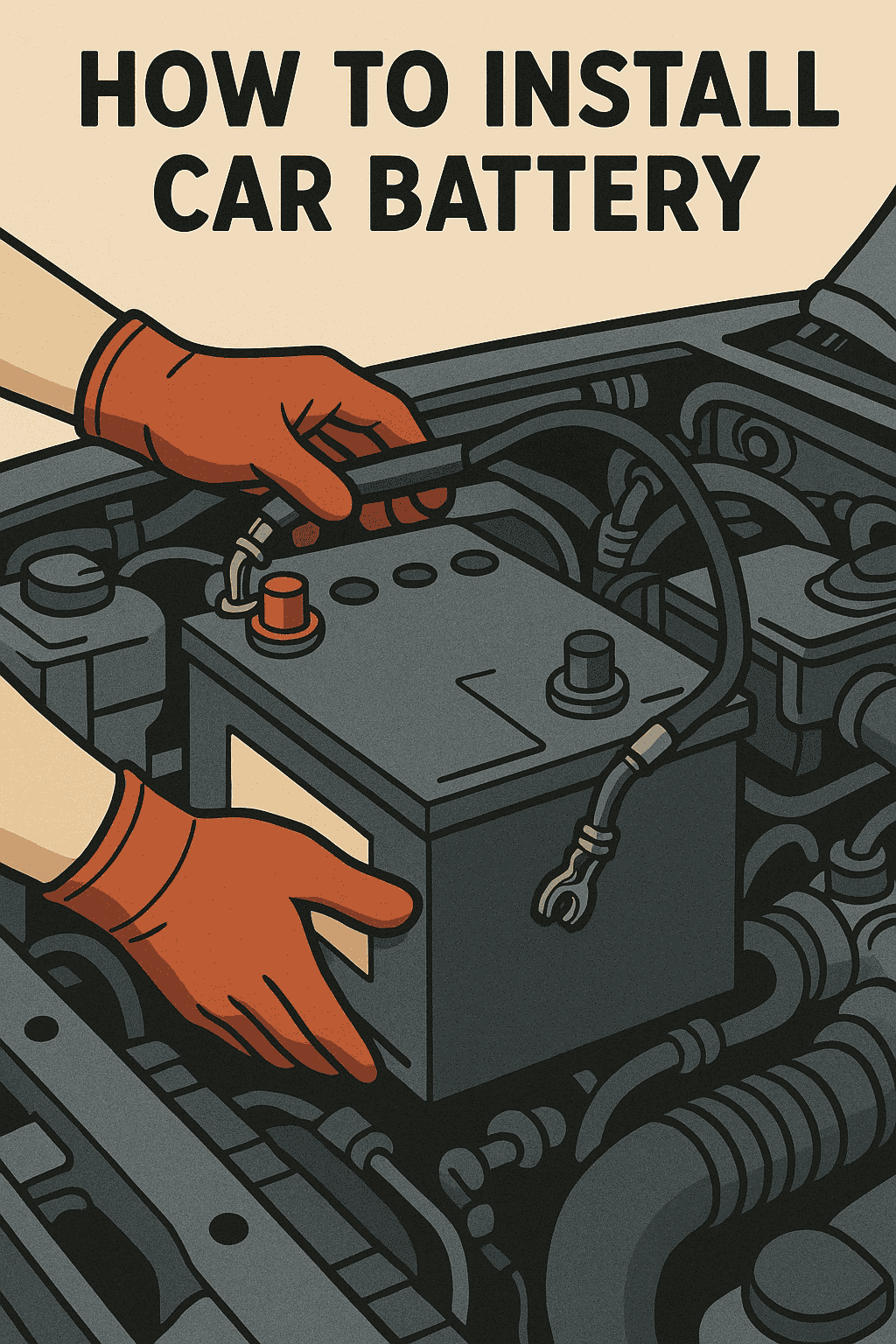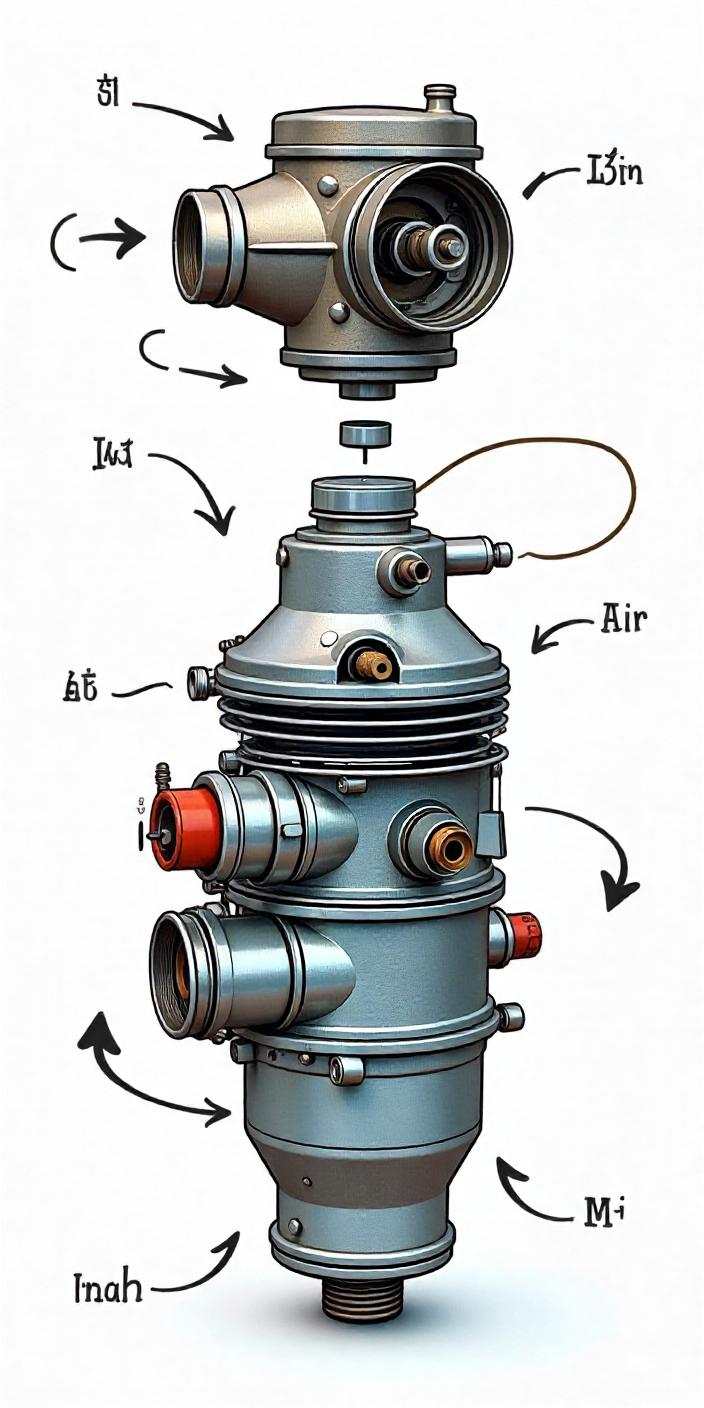How To Install Car Battery: A Comprehensive Guide
Jumping into the world of car batteries, let’s kick off the engine of this guide with something simple but crucial. Installing a car battery might sound like a job for the mechanic down the road, but with the right tools and a dash of confidence, it’s a task you can tackle on your driveway.
Whether you’re dealing with a beast under the bonnet or a battery tucked away in the boot, each vehicle has its unique setup. However, the essence of battery care and maintenance remains constant across the board.
Every vehicle, from the robust Ford Falcon with its battery proudly sitting in the engine bay to the VE Commodore with its power source stashed in the boot, falls on a spectrum of battery installation difficulty.
And then there’s the elegant design of some European vehicles, like the VW Touareg, hiding the battery under the passenger’s seat, making one wonder whether it’s a car or a treasure hunt. Fear not, for this guide aims to shine a light down the path of replacing car batteries, ensuring you’re not left in the dark (or worse, stranded) when it’s time for a change.
Car batteries might not have a voice, but they certainly know how to make themselves heard through their performance. Like the heart of your vehicle, they keep everything else running smoothly, from the headlights guiding you through the night to the air conditioner keeping you cool during those hot summer drives.
They’re the unsung heroes of the automotive world, and today, you’re going to learn how to give your vehicle’s hero the update it deserves.
As we roll up our sleeves and dive into the nitty-gritty of battery installation, keep in mind that this isn’t just about replacing an old piece of equipment. It’s about ensuring your ride continues to hum along smoothly, taking you from point A to B without a hitch.
So, let’s gear up and get ready to power through this guide together, making sure you’re equipped to keep your ride running as smoothly as silk on any road you travel.
Before You Begin: Understanding Your Car Battery
Before we hurdle into swapping out batteries, it’s crucial to set the stage right. Imagine parking your ride on a level street, setting that parking brake like a pro, and giving your car a break to cool down, especially if it’s been running hotter than a July afternoon.
Safety isn’t just a word; it’s a suit of armor. So, pull on those safety goggles, strap on some gloves, and secure back any long hair. Glittering jewelry and loose threads have no place under the hood, and smoking? That’s a big no, especially when you’re about to get up close and personal with your battery.
Now, the arena’s prepared, and it’s time to talk about the main event: your battery. Lead-acid batteries are like the hidden warriors of the automotive realm, churning out power silently under the hood. These energetic boxes might look no-nonsense, but they’re the lifeblood of your vehicular adventures, making sure every start is as smooth as the last.
Before we jumpstart the installation process, squirreling away a bit of know-how about these power packs will not only smooth out the process but also ensure you’re treating your car to the best care possible.
What Is a Car Battery and How Does It Work?
At its core, a car battery isn’t just any battery; it’s an automotive battery, a powerhouse designed to do one thing supremely well: provide the electrical juice needed to start your engine and power your car’s electrical gadgets.
Nestled snugly under the hood (or in some unique spots for the adventurous car designers), these lead-acid batteries are the unsung heroes, holding the keys to the ignition literally and figuratively. They combine chemistry and elbow grease (the electrical kind) to transform chemical energy into electrical power, giving your car that pep in its step from a cold start.
The magic starts when you turn the key or push the button. That action sends a signal – like a starter’s pistol announcing the onset of a race, calling the battery into action. The battery leans into the challenge, sending a hefty surge of power to the starter motor, which in turn gets those pistons moving. But the job isn’t done there; it continues to supply essential power to keep the show on the road, powering everything from the stereo that plays your favorite tunes to the lights that guide your way. It’s a relentless powerhouse, and understanding this gives you a glimpse into the soul of your vehicle.
Identifying Signs of Battery Failure
Let’s face it, nobody likes bad news, especially when it comes from the silent sentry under the hood – your car’s battery. Recognizing the telltale signs of a battery gearing up to bid adieu can save you a ton of headache down the road.
Slow starts, the dreaded click without the engine turning over, or the electrical components acting like they’re on a slow-motion replay are all cries for help. It’s the battery’s way of whispering (or sometimes shouting) that it might be time for a change. It’s like the battery is saying, “Hey, I’ve done my bit, how about we freshen things up a bit?”
When to Consider Battery Replacement
Knowing when to swap out an old battery for a shiny new one can feel a bit like reading tea leaves if you’re not paying attention. However, there are a few clear signs that it’s time to bid farewell.
If your car’s taking longer to start, if lights dim when you’re starting the engine, or if that dashboard battery light flickers like a haunted house, it’s time to sit up and take notice. Car batteries usually have a lifespan, and like bread, they don’t get better with age. It’s all about keeping an eye out and staying ahead of the game to avoid getting stranded.
Maintaining a check on your battery’s health and replacing it before it throws in the towel can feel like a chore, but it’s a crucial step in ensuring your car stays reliable.
After all, your vehicle’s battery is the silent guardian that keeps everything ticking. Regular check-ups and understanding when performance dips can save you from unexpected hiccups on the road, ensuring your journey remains as smooth as the day you first turned the key.
Preparing for Battery Installation
Safety First: Essential Precautions
Before diving into the battery swap, safety’s gotta come first, no if’s or but’s. Park that ride on flat, dry ground and yank up the parking brake tight. Make sure the ignition is as off as your alarm clock on a Saturday.
If the engine’s been running, let her cool down because nobody’s looking to get a heat tattoo from the engine. And eyewear along with gloves? Non-negotiable. Keep those peepers and fingers shielded. Lastly, loose clothing or bling could turn a simple job into a wrestling match with the car parts. Keep it tidy and safe, folks.
Oh, and one more golden rule – no puffing smokes under the hood. Those batteries, they’re not just sitting there; they’re filled with stuff waiting to turn your simple battery change into a blockbuster explosion scene. Not the kind of fireworks we want to see.
Gathering the Necessary Tools
To swap that car battery safely, you’re gonna need more than just elbow grease. Grab a new battery that’s the right fit for your ride, because not all car batteries wanna get cozy with every car. Don’t forget gloves and goggles, because this ain’t a soap opera – you wanna see the drama, not be part of it.
A wrench is key, with several socket sizes on standby, because you never know which one’s gonna be the hero of the day. Cleaning towels, a wire brush, or something of the sort should be in your arsenal too, for scrubbing away the sins of the old battery. And maybe a terminal puller if you’re feeling fancy, but that’s your call.
Once you’ve herded all these tools together, you’re set to roll up those sleeves and get to work. Remember, changing a car battery ain’t like changing a light bulb. A little prep goes a long way toward keeping your car from acting like it’s got a mind of its own.
Step-by-Step Battery Replacement Process
Replacing a car battery is like the heart transplant of the automotive world. Without it, your ride’s just a big metal paperweight. The interior lights, the music for your road trips, even getting the engine running, all hang on this bad boy.
And with cars being more like rolling computers these days, slapping in the right type of battery matters more than ever. Don’t sweat it though. As long as you follow the steps, you’ll have that engine purring in no time.
1. Switch Off the Car and Open the Hood
Alright, first thing’s first. Kill the engine. We’re not looking for any surprises while we’re wrists deep in the engine bay. Give it a few to let that electrical energy fade off. It’s like waiting for the toaster to cool down – patience prevents burnt fingers. Then, pop the hood; that’s your stage for today’s performance.
Cars get hot under the collar after a run, and we’re not in the business of roasting hands today, are we?
Waiting a bit ensures you’re not getting an unexpected jolt of energy. Reducing the risk starts with cutting off the power supply, making your battery swapping saga as smooth as a jazz solo.
2. Locate and Disconnect Battery Terminals
Once you’ve given the engine its peace, it’s time to find where the heart of the beast sleeps – the battery. Some cars like to keep it under the hood, others might tuck it away in the trunk.
If it feels like you’re playing hide and seek, the owner’s manual is your clue to find where the battery’s hiding. Now, approach the battery terminals with the respect they deserve. They’re not just metal; they’re the lifeblood connectors for your car’s electrical system.
Sequence Matters: Negative Before Positive
Here’s where the dance starts. You always, and I mean always, start with the negative terminal. Why? Think of it as unplugging the TV before you start messing with the cables. It’s about safety, folks. That way, you’re less likely to turn a simple battery change into a spark show. Use a wrench to loosen the nut, get a good twist, and pull that cable off gently. No forcing, no rush. Treat it like you’re disarming a bomb in an action movie.
After the negative’s off, then and only then, you go for the positive terminal. It’s the same delicate dance – loosen, twist, and pull with grace. This sequence is like a sacred ritual in the car maintenance world. Follow it, and you keep the drama to a minimum. Plus, it’s a surefire way to make sure you’re moving forward safely and efficiently, ready to welcome the new battery into its cradle.
3. Remove the Old Battery from Its Tray
Before one tackles the task of removing the battery, it’s crucial to check if there are any clamps firmly holding it in place. Sometimes, a socket extension is what it takes to loosen those stubborn clamps. It’s important to inspect the battery’s exterior thoroughly because clamps can be sneaky and hide in plain sight. Once located, gloves should be put on to deal with the battery acid risk.
Those clamps and any other fasteners should be carefully set aside. Then, with safety glasses protecting the eyes from potential battery acid splashes, it’s time to lift the battery.
These hefty units, weighing about 40 to 60 pounds, can seem like they’re cemented in place. If the battery comes with a handle, that’s a blessing and should be used to ease the lift. In stubborn cases, a battery terminal puller can save the day, much better than improvising with potentially damaging metal objects.
Inspect the Battery Tray and Clean If Necessary
Once the old battery has made its exit, the spotlight turns on the battery tray. This tray, having had a weighty companion for so long, deserves a thorough inspection. Here’s where the magic of baking soda comes into the scene.
A simple mix of baking soda and water can work wonders, scrubbing away any corrosion or residues that might’ve been partying on the tray. A clean tray is not just about being neat; it’s about laying down a clean welcome mat for the new battery.
After giving the battery tray a good scrub and ensuring it’s dry and free from any party leftovers of corrosion or debris, it’s almost time to install a car battery.
But hold that thought! Ensuring the tray is aligned correctly is paramount. An uneven tray can result in unnecessary complications down the road (pun intended). With the tray inspection complete and cleanliness assured, the stage is set for the new battery’s grand entrance.
4. Install the New Battery
Before the new battery makes its debut, those tiny red and black plastic hats on the battery posts must take a bow and exit stage left. Then, giving the battery posts a little extra love with anti-corrosion washers is always a good move.
Remember, a sprinkle of anti-corrosion solution on the car’s terminal ends keeps the electrical relationship running smoothly. With the stage set, gently slot the new battery into the battery tray, ensuring a perfect match between the positive and negative ends with their respective terminals on the car.
Final act? Reinstalling the clamp(s) the exact way they were removed, securing the battery firmly in its place and ensuring the show goes on without a hitch.
Securing the Battery in Place
Now, it’s time to make sure that new battery isn’t going anywhere. How? By consulting the trusty owner’s manual. This gem holds the key to the specifics, including how tight those clamps should be. It’s all about finding that sweet spot; tight enough to keep the battery secure without making it a mission to remove next time. The manual knows it all.
While we’re on the subject, here’s something to chew on: the terminal is typically marked for easy identification, but mistakes happen. Double-checking that the positive and negative terminals are cozying up to their correct partners is a step that’s worth its weight in gold. A mix-up here can turn a smooth operation into an electrifying drama nobody signed up for.
5. Reattach the Battery Terminals
With the new battery snug in its tray, it’s time to bring it to life by reattaching the battery terminals. This isn’t just about connecting bits of metal; it’s about awakening the car’s battery to return the vehicle to its vibrant self. But before diving in, it’s smart to brush up on some maintenance tips to keep that connection clean and corrosion-free. This isn’t a one-time gig; it’s a long-term relationship.
Positive Before Negative: The Correct Order
Reattaching the terminals starts with a golden rule: positive before negative. This isn’t just a catchy phrase; it’s a safety measure. Hooking up the positive terminal first reduces the risk of a shocking experience, making the process smoother for everyone involved. Plus, it’s about respect – giving the car’s electrical system the gentle hand it deserves.
Once the positive terminal is securely connected, completing the circuit with the negative terminal is next on the agenda. This step feels somewhat like a ritual, finalizing the connection and ensuring everything is set for ignition. With both terminals attached rightly, the car’s battery is ready to support countless journeys, turning the key into the start of new adventures.
6. Testing Your Installation
Once you’ve got that shiny new battery snug as a bug in its tray, it’s showtime, folks. Fire up the engine and keep an ear out for the sweet purr that says, “Good job!” If the car starts without a fuss, tip your hat to a job well done. But hey, don’t just take the engine’s word for it. Flip on those lights, pump up the jam on the radio, and give the AC a whirl. Every gadget that needs juice from the battery should be working if you’ve played your cards right.
If things aren’t lighting up or you’re getting more clicks than a high school photography class, something’s amiss. Double-check your connections; maybe a cable’s loose or got mixed up—easy fix. But if everything’s tight and right, and you’re still not in business, you might be dealing with a bigger gremlin than you thought. That’s when you tap out and tag in a pro mechanic to suss it out.
Post-Installation Tips
Alright, you’ve crossed the finish line with the installation, but don’t throw in the towel just yet. First off, take a victory lap by making sure your workspace is cleaner than a whistle. Gather all your tools, sweep up any debris, and give your hands a good scrub—battery acid and grime don’t mix well with dinner. Consider giving the car a quick spin around the block, just to be sure everything’s copacetic under the hood and out in the wild.
And another thing, don’t let that old battery sit around like yesterday’s news. Most places that sell batteries will take the old clunker off your hands for recycling. Not only do you get brownie points for being eco-conscious, but you also keep your garage from turning into an episode of “Hoarders.” Plus, dropping off that old battery is a good excuse to check out the latest gizmos and gadgets at the auto parts store.
How to Properly Dispose of Your Old Battery
Remember, tossing an old battery into the trash is a no-go. These things are packed with chemicals that can throw a real fit if they end up in the landfill. So, after you lift the battery, decked out in safety glasses and gloves like a DIY superhero, make a beeline for a recycling center or swing by the auto shop. They know how to handle these bad boys, keeping the planet safer and your conscience clear.
And about those gloves and safety glasses—you’re not just wearing them for the fashion statement. Battery acid is no joke, highly corrosive and can turn a good day south fast. Keep metal objects, like tools and rings, away from the battery terminals to avoid any sparks. Safety first, because nobody looks cool with acid burns or sparking a garage fireworks show.
Maintaining Your New Car Battery for Longevity
Now that you’ve got a fresh battery powering your ride, it’s like a new lease on life for your car. But don’t take it for granted. To keep the good times rolling, check on the battery now and then. Look out for dim headlights or a slow crank; they’re the battery’s way of saying, “Help me!” Keeping the terminals clean and ensuring the battery is snug and secure is like giving your car a hug—it’ll love you back with more reliable starts and smoother rides.
Another pro tip: Use your car regularly. Letting it sit idle is like telling the battery it’s okay to be lazy. And a lazy battery is a battery that won’t get you to work on Monday. If you’re not going to drive for a while, consider a trickle charger to keep the battery in tip-top shape. It’s all about giving that new battery a long and happy life, guiding you through many more journeys to come.
When to Seek Professional Help
There’s no shame in calling in the cavalry if things with your new battery aren’t quite kosher. Sometimes, the battery’s not the troublemaker; it’s another gremlin lurking in the car’s electrical system. When you’ve got headlights dimming like a moody jazz club or the radio cuts in and out, it might be more than a simple battery issue.
Especially if you’ve swapped batteries and the car’s still throwing tantrums, you might be dealing with a faulty alternator. That’s your cue to flag down a pro who can run a deeper diagnostic. Mechanics have the tools and know-how to pinpoint the trouble and get you back in the fast lane. So, if you’re scratching your head, wondering why your car’s acting up, it’s time to phone a friend with a tool belt.
Troubleshooting Installation Issues
Installed that battery and now things are looking a bit sideways? Hold your horses. If the car’s acting like it forgot how to car, let’s backtrack. Double-check those connections. A mix-up between the negative and positive terminals is an easy slip that’ll throw a wrench in the works. And make sure those cables are as snug as a bug; a loose connection can cause more drama than a reality TV show.
If after playing detective everything seems in order but your ride still won’t start, it might be time to look under the hood for other suspects. A dodgy electrical system can be a silent saboteur, making you think it’s a battery issue when there’s a bigger fish to fry. And if “faulty alternator” starts sounding less like car jargon and more like your current situation, don’t hesitate to get a mechanic on the horn. They’ll figure out if your car’s just being high maintenance or if it’s truly time for an intervention.
Recognizing When It’s More Than a Battery Problem
Sometimes, it feels like the world’s playing a funny game, telling you it’s just the battery when, in fact, your car’s acting up for a whole different reason. Let’s start simple: if you swap out the battery and your ride still won’t start, or if it’s doing the electric slide with your dashboard lights, you might be looking at a different party crasher. Electrical issues can play a wicked game of hide and seek, where the starter or alternator might be the ones actually throwing a fit.
And hey, don’t forget the head-scratcher when your car starts fine one day and then decides to go on strike the next. This could shout out loud that it’s not just a battery drama but could be something more like a fuel system having a bad day or maybe those spark plugs aren’t feeling sparky anymore. If giving the battery a fresh start doesn’t get your motor running, it may be time to call in the pros. It’s like getting a mystery puzzle box; if you don’t have all the right pieces, sometimes you need someone who’s got the whole set to help figure it out.
Powering Forward: Ensuring a Smooth Ride
After wrestling with automotive batteries and armed with a trusty socket wrench, anyone can feel like a pit-stop hero. But the victory lap doesn’t end with a freshly installed car battery. To avoid a dead car battery turning mornings into a guessing game of “Will it start?” it pays to give that battery some TLC. Regular checks to make sure it’s snug and clean can save a whole lot of headache. Plus, keeping it clean isn’t just about looking pretty; it’s about making sure nothing’s gonna start a fuss down the road.
Now, not everyone’s got the time or the know-how to play car doctor. That’s where the local service center comes into play. These wizards can work their magic, checking things most of us wouldn’t even think of. But here’s a little trade secret: when things go sideways, and the car refuses to turn over, knowing how to troubleshoot can save the day. Sometimes, all it takes is repeating the process of securing connections or giving the terminals a good scrub to see a smile on that car’s face.
Turning the key to hear that engine purr is what it’s all about. But let’s not forget, cars are more than just machines; they convert all that chemical energy from the battery into the mechanical energy that keeps us moving. So, keeping an ear to the ground and an eye on the battery’s health is key to a smooth ride. And when in doubt, a visit to the service center can ensure that the journey continues without a hitch.







